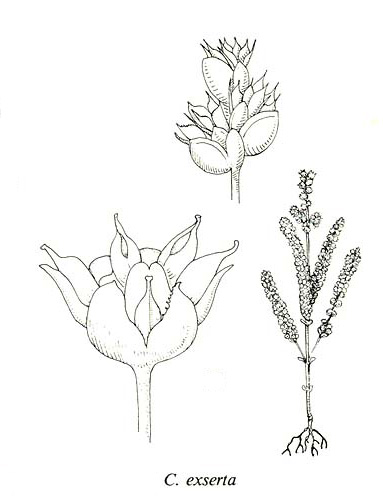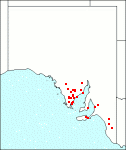Family: Crassulaceae
Crassula exserta
Citation:
Ostenf., Dansk bot. Ark. 2, 8:48 (1918).
Synonymy: Tillaea exserta Reader, Victorian Nat. 14:83 (1897).
Common name: Large-fruited crassula.
Description:
Annuals with erect stems to 15 cm long, little branched and mainly from the base; leaves lanceolate, 1.5-3 x 1-2 ram, obtuse, rarely acute, slightly constricted towards the base, flat or almost so above and strongly convex below, fleshy, glabrous to rugose, green to deep-red.
Inflorescence one sometimes several thyrses, rarely panicles, with sessile dichasia in the-axils of leaf-like bracts; pedicels 0.5-5 mm long when fruiting; flowers 5-merous; calyx lobes lanceolate, 1-1.3 mm long, pointed, fleshy, green to red but with a colourless terminal point; corolla cup-shaped, scarcely fused at the base, white to red; lobes linear-lanceolate, 0.8-1 mm long, sharply acute, spreading; nectary scale linear, rounded to truncate, scarcely constricted towards the base, slightly fleshy, white; ovaries almost cylindrical, abruptly constricted into short styles, with 2 ovules.
Follicles erect, papillose to tuberculate, releasing seeds through a large apical pore but the lower seeds usually retained as the pericarp breaks off only after the calyx, which clasp the follicles, has decayed.

| Crassula exserta
|
Image source: fig 228b in Jessop J.P. & Toelken H.R. (Ed.) 1986. Flora of South Australia (4th edn).
|
|
|
Distribution:
|
Widespread but never common in Australia. Grows in a wide range of habitats often together .with C. colorata and C. sieberana subsp. tetramera.
S.Aust.: EP, SL, SE. W.Aust. (mainly in the southern section); Vic. (western section); Tas. (King Island).
|
Conservation status:
native
Flowering time: No flowering time is available |

SA Distribution Map based
on current data relating to
specimens held in the
State Herbarium of South Australia
|
Biology:
Young plants are often not distinguishable from C. sieberana subsp. tetramera since they also have 4-merous flowers.
Author:
Not yet available
|

